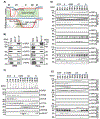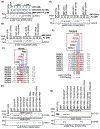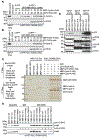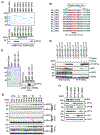Multiple, short protein binding motifs in ORC1 and CDC6 control the initiation of DNA replication
- PMID: 33761311
- PMCID: PMC8106667
- DOI: 10.1016/j.molcel.2021.03.003
Multiple, short protein binding motifs in ORC1 and CDC6 control the initiation of DNA replication
Abstract
The initiation of DNA replication involves cell cycle-dependent assembly and disassembly of protein complexes, including the origin recognition complex (ORC) and CDC6 AAA+ ATPases. We report that multiple short linear protein motifs (SLiMs) within intrinsically disordered regions (IDRs) in ORC1 and CDC6 mediate cyclin-CDK-dependent and independent protein-protein interactions, conditional on the cell cycle phase. A domain within the ORC1 IDR is required for interaction between the ORC1 and CDC6 AAA+ domains in G1, whereas the same domain prevents CDC6-ORC1 interaction during mitosis. Then, during late G1, this domain facilitates ORC1 destruction by a SKP2-cyclin A-CDK2-dependent mechanism. During G1, the CDC6 Cy motif cooperates with cyclin E-CDK2 to promote ORC1-CDC6 interactions. The CDC6 IDR regulates self-interaction by ORC1, thereby controlling ORC1 protein levels. Protein phosphatase 1 binds directly to a SLiM in the ORC1 IDR, causing ORC1 de-phosphorylation upon mitotic exit, increasing ORC1 protein, and promoting pre-RC assembly.
Keywords: CDC6; DNA replication; PP1 phosphatase; cell division cycle; cyclin-dependent protein kinases; initiation; liquid-liquid phase transition; origin recognition complex; protein degradation; short linear protein motifs.
Copyright © 2021 Elsevier Inc. All rights reserved.
Conflict of interest statement
Declaration of interests B.S. is a member of the science advisory board of Circle Pharma and is an advisor to EnGeneIC and Pfizer. The authors declare no competing interests.
Figures







Comment in
-
SLiMs in intrinsically disordered protein regions regulate the cell cycle dynamics of ORC1-CDC6 interaction and pre-replicative complex assembly.Mol Cell. 2021 May 6;81(9):1861-1862. doi: 10.1016/j.molcel.2021.04.016. Mol Cell. 2021. PMID: 33961774
Similar articles
-
SLiMs in intrinsically disordered protein regions regulate the cell cycle dynamics of ORC1-CDC6 interaction and pre-replicative complex assembly.Mol Cell. 2021 May 6;81(9):1861-1862. doi: 10.1016/j.molcel.2021.04.016. Mol Cell. 2021. PMID: 33961774
-
Opposing roles for DNA replication initiator proteins ORC1 and CDC6 in control of Cyclin E gene transcription.Elife. 2016 Jul 26;5:e12785. doi: 10.7554/eLife.12785. Elife. 2016. PMID: 27458800 Free PMC article.
-
Cyclin E uses Cdc6 as a chromatin-associated receptor required for DNA replication.J Cell Biol. 2001 Mar 19;152(6):1267-78. doi: 10.1083/jcb.152.6.1267. J Cell Biol. 2001. PMID: 11257126 Free PMC article.
-
DnaA, ORC, and Cdc6: similarity beyond the domains of life and diversity.Biochem Cell Biol. 2010 Feb;88(1):49-62. doi: 10.1139/o09-154. Biochem Cell Biol. 2010. PMID: 20130679 Review.
-
The origin recognition complex protein family.Genome Biol. 2009;10(3):214. doi: 10.1186/gb-2009-10-3-214. Epub 2009 Mar 17. Genome Biol. 2009. PMID: 19344485 Free PMC article. Review.
Cited by
-
ORC1 binds to cis-transcribed RNAs for efficient activation of replication origins.Nat Commun. 2023 Jul 24;14(1):4447. doi: 10.1038/s41467-023-40105-3. Nat Commun. 2023. PMID: 37488096 Free PMC article.
-
CRL4Cdt2 Ubiquitin Ligase, A Genome Caretaker Controlled by Cdt2 Binding to PCNA and DNA.Genes (Basel). 2022 Jan 29;13(2):266. doi: 10.3390/genes13020266. Genes (Basel). 2022. PMID: 35205311 Free PMC article. Review.
-
Reconstitution of human DNA licensing and the structural and functional analysis of key intermediates.Nat Commun. 2025 Jan 8;16(1):478. doi: 10.1038/s41467-024-55772-z. Nat Commun. 2025. PMID: 39779677 Free PMC article.
-
Molecular determinants of phase separation for Drosophila DNA replication licensing factors.Elife. 2021 Dec 24;10:e70535. doi: 10.7554/eLife.70535. Elife. 2021. PMID: 34951585 Free PMC article.
-
The structure of ORC-Cdc6 on an origin DNA reveals the mechanism of ORC activation by the replication initiator Cdc6.Nat Commun. 2021 Jun 23;12(1):3883. doi: 10.1038/s41467-021-24199-1. Nat Commun. 2021. PMID: 34162887 Free PMC article.
References
-
- Bashir T, Dorrello NV, Amador V, Guardavaccaro D, and Pagano M (2004). Control of the SCFSkp2–Cks1 ubiquitin ligase by the APC/CCdh1 ubiquitin ligase. Nature 428, 190–193. - PubMed
-
- Bell SP, and Stillman B (1992). ATP-dependent recognition of eukaryotic origins of DNA replication by a multiprotein complex. Nature 357, 128–134. - PubMed
Publication types
MeSH terms
Substances
Grants and funding
LinkOut - more resources
Full Text Sources
Other Literature Sources
Molecular Biology Databases
Research Materials
Miscellaneous

